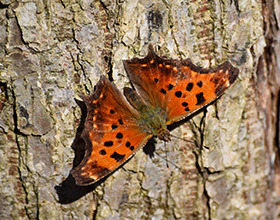 It’s midwinter and, as I write this, temperatures are predicted to remain below freezing for the January week ahead. Not a great time to go out looking for butterflies! Chances are, though, that the remaining weeks of winter will include a few warmer days, little previews of the springtime to come. When those days arrive, it won’t be surprising to see a flutter of bright orange out among the tree trunks. Butterflies!
It’s midwinter and, as I write this, temperatures are predicted to remain below freezing for the January week ahead. Not a great time to go out looking for butterflies! Chances are, though, that the remaining weeks of winter will include a few warmer days, little previews of the springtime to come. When those days arrive, it won’t be surprising to see a flutter of bright orange out among the tree trunks. Butterflies!
Like most insects, butterflies depend on the environment—air temperature and sunshine—to achieve body temperatures warm enough to support bodily functions like flying, feeding, and reproduction. So, when temperatures cool in the fall, butterflies disappear from the landscape. A few species—monarchs most famously—accomplish that by migrating south. But most butterflies remain local and survive the cold months in a state of suspended development. Banded hairstreaks accomplish that as eggs; great spangled fritillaries and red-spotted purples overwinter as caterpillars (larvae); azures and swallowtails spend the winter in the chrysalis (pupal stage). Only a handful of species overwinter as adults. Among those are two local species in the “anglewing” group: the eastern comma (Polygonia comma) and the question mark (Polygonia interrogationis).
The name “anglewing”, like the genus name Polygonia, refers to the butterflies’ multi-angled wing shape. For both commas and question marks, the upper forewing surface is bright orange with dark spots, including a row of three spots in the comma and four in the question mark. The underside of the wings is mottled brown, which provides outstanding camouflage when the animals sit on a tree trunk with wings held upright. In the middle of the hindwing underside is the small decoration that gives each species its name: a silvery comma-shaped mark in the one species, a similar mark with an extra dot nearby—reminiscent of a written question mark—in the other.
The life cycles of commas and question marks include two generations per year. The butterflies that overwinter emerge to mate and lay eggs in spring. It takes several weeks for those eggs to hatch and complete the transition to adulthood. Those adults have hindwings with nearly uniformly dark upper surfaces. They live for just a few weeks, during which time they mate and lay their own eggs. Summer-form (dark-winged) commas and question marks are observed in Greene and Montgomery Counties from about May until September.
In contrast, eggs laid by those summer butterflies produce adults with hindwing upper surfaces that match the forewings (bright orange with dark spots). Those adults can be observed locally starting in about September or October. However, not long after appearing on the scene, the decreasing day length of autumn induces them to enter diapause—the state of suspended animation that is sustained through winter. In females, that process includes inhibited maturation of the reproductive organs, so that eggs are not produced until after diapause ends. For males, though, sperm are produced in fall and stored over winter. The adults hide out over winter in tree crevices or similar sites. After they emerge in springtime, they mate, lay eggs, and die by April or May, having lived for about 8 months.
Overwintering commas and question marks face two major challenges. First, they must survive on the energy they accumulate during fall. That is made possible by the combined effects of diapause and cold temperatures, both of which reduce the rates of energy use.
The second challenge is that butterflies’ bodies track environmental temperatures, and so during cold spells they risk freezing. Some insects (and other animals) actually can survive body water turning to ice. However, overwintering anglewing butterflies use a different strategy. That is, they avoid freezing, even when air temperatures drop below the normal freezing point of body fluids. To do so, they accumulate glycerol in their bodies, which lowers the freezing temperature much like antifreeze in a car radiator. (Glycerol is an organic alcohol that the insects probably synthesize from fat.) Glycerol also enhances the animals’ ability to “supercool,” meaning that their body fluids can remain liquid, without forming ice, even at temperatures below the freezing point. Some butterflies can chill below -20C (-4 F)—colder than a home freezer—while remaining in a liquid state.
That absence of actual freezing avoids potentially lethal damage from bodily ice (think of the damage ice can do to roadways). But the absence of freezing also means that the butterflies can arouse from dormancy relatively rapidly if temperatures warm. And that is exactly what happens on the occasional warm winter day. Commas and question marks can potentially be sighted in every month of the year in Ohio (though, for unknown reason, commas are sighted in winter significantly more often than question marks.) Of course, there are no flowers to feed on in January or February. But that’s ok for these two species; they prefer to sip liquids from tree sap—a tree tapped by sapsucker woodpeckers is perfect—or from rotting fruit, puddles, or other sources. The extra energy helps to carry the butterflies through the rest of winter and to fuel reproduction after springtime emergence.
So, right now it’s time to play in the snow and enjoy the cold. But at the same time, we can look forward to warmer weather that’s sure to come. If a few days of that warmth arrive in February, then look out for flashes of orange as you wander the woods. And don’t hesitate to shout out: it’s a butterfly! Exclamation point!
Article and photo contributed by Dr. David L. Goldstein, Emeritus Professor, Department of Biological Sciences, Wright State University.
